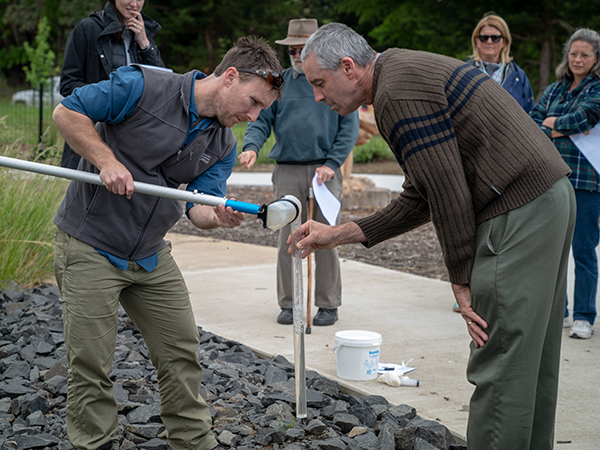eDNA testing helping to create healthy farm dams

Demonstrating the testing of turbidity levels at Neerim South wetlands.
Did you know every creature leaves traces of DNA in their surrounding environment, through skin cells, hair, scales and other bodily secretions? Known as environmental DNA, or eDNA for short, it is a new way of detecting wildlife that Victorian-based company, EnviroDNA is at the forefront of.
Using innovative technology, scientists are able to extract DNA from a sample of water and use it to identify the animal, plant or organism that left it behind. The unique sequence of each DNA molecule is then analysed for matches against a database of species. By providing evidence of what is – or is not – present in an environment, eDNA is a genetic fingerprint that offers the opportunity to monitor endangered and invasive species, biodiversity and biosecurity.
In November 2018, the team at EnivroDNA began working with Jindivick Landcare Group and Neerim District Landcare Group to collect water samples from 16 farm dams across the West Gippsland region. These water samples will be tested to detect eDNA, giving farmers information on the health of their water and what wildlife might be present on their property.
Dams are a critical resource on farms for irrigation and stock watering, but they also play an important role in
creating biodiversity in agricultural landscapes. According to Land & Water Australia there are over two million farm dams in Australia.
The aim of the project is to map the biodiversity across farm dams in order to determine their suitability to support local wildlife and improve the agricultural landscape.
For Phil Darton, from Neerim District Landcare Group, it is an exciting opportunity.
“I think dams are a resource we haven’t looked at in providing a corridor system for wildlife,” he said. “We’ve looked at streams, we’ve looked at creeks, but we haven’t looked into dams before.”
Local farmer and fellow group member Lindsay Lockett agrees, highlighting the benefits of a healthy dam for productivity.
“This project enables me to explore the water health of my dams which is important for protecting my livestock,” Lindsay said. “They’re my livelihood; I don’t want them getting sick.”
Increasing biodiversity in and around farm dams is an opportunity to make farming more ecological sustainable.
“For farmers, there is an enormous benefit to productivity from a healthier and more biodiverse dam,” Helen Barclay, EnviroDNA managing director said. “Through our testing we are interested in finding out how dams can be a sustainable support system for local wildlife in order to increase overall farm health. It offers a win-win situation.”
To stay informed about EnviroDNA’s research contact Helen Barclay at [email protected].



